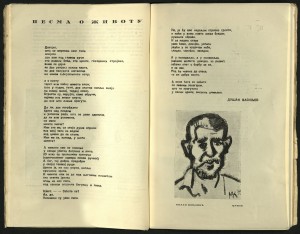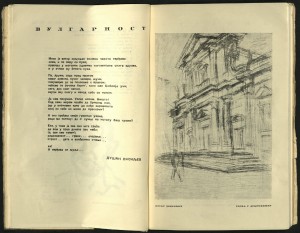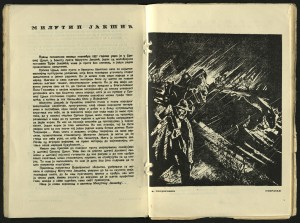Tags
Arad, art, artists, Begrade, Bogdan Ciplic, Bogdan Suput, Bogdan Teodorovic, Budapest, children's literature, colorism, cubism, culture, Europe, fascists, German, Hungarian, Hungary, impressionism, Ivan Tabakovic, journal, landscapes, linocuts, Milan Konjovic, Milenko Sevan, modernist, Munich, Nava Sudarska, Novi Sad, Paris, Petar Dobrovic, portraits, Prague, prisoner-of-war, Romania, Serbia, Serbian, Serbo-Hungarian Baranya-Baja Republic, Sima Cucic, Stepan Bonarov, Vojvodjansk, Vojvojdina, woodcuts, World War II, Yugoslavia, Zagreb
Vojvodjanski zbornik: almanah. vols. 1 (1938) and 2 (1939)
Novi Sad: S.n., 1938-1939
PG1400 I5 V64
This journal of art and culture was produced in Vojvojdina, an autonomous province of Serbia, on the eve of the second World War. The journal, published in these two issues only, assembled the work of modernist artists and writers of the region, including many contributors whose work is otherwise unpublished or unrecorded. Many of the artists and writers did not survive the war.
The journals include prose, poetry and, in the first volume, illustrations – including original graphic works (woodcuts and linocuts) by Bogdan Teodorovic, Stefan Bodnarov, Milan Konjovic (1898-1993), Milenko Servan, Bogdan Suput (1914-1942), Ivan Tabakovic (1898-1977), Nava Sudarska, Petar Dobrovic (1890-1942) and others.
The journal was edited by Bogdan Ciplic and writer and critic Sima Cucic (1905-1988). Today in Serbia, annual awards for achievements in the field of children’s literature are given in the name of Sima Cucic.
Milan Konjovic (1898-1993) became a prominent Serbian painter. He went to school in Prague, lived in Paris between 1924 and 1932 and traveled throughout Europe before returning to Vojvodjansk. He survived a German prisoner-of-war camp.
Bogdan Suput, considered one of the great Serbian painters of the first half of the twentieth century, was born in 1914. He also spent time in Paris. In 1939 he returned to Belgrade where he became a member of the art group, “Ten.” That April, the Germans invaded Yugoslavia. Suput survived German captivity, but was shot by Hungarian fascists in Novi Sad in 1942. An art school in Novi Sad, begun sixty years ago, is named after him.
Ivan Tabakovic was born in Arad, Hungary (now Romania). He studied art in Budapest and Zagreb. He traveled briefly in Munich. In 1930 he moved to Novi Sad and began teaching in Belgrade in 1938.
Petar Dobrovic, a proponent, along with Milan Konjovic, of Serbian colorism, was known for his portraits and landscapes. He experimented with impressionism and cubism. He was President of the short-lived, small Serbo-Hungarian Baranya-Baja Republic in 1921. He died in Belgrade during the German occupation.





You must be logged in to post a comment.